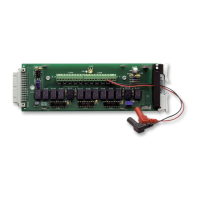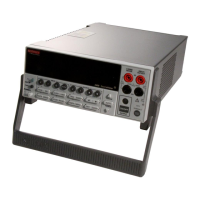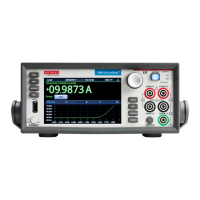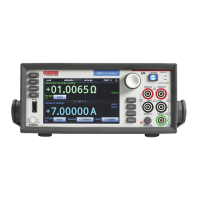3: Functions and features Model 2450 Interactive SourceMeter® Instrument
3-66 2450-901-01 Rev. B/September 2013
Controlling digital I/O lines
You must use a remote interface to set up and control the digital I/O lines. See Remote
communication interfaces (on page 2-44) for information on setting up a remote interface and
choosing a command set.
You can control each digital I/O line using the trigger model or directly as a digital line that is not
controlled by the trigger model. Use any of the Model 2450 digital I/O lines in one of three modes:
input, output, or open-drain. When a line is used in an open-drain mode, you must write a 1 to any
digital I/O line that is used as an input. By default, each line is configured as a digital line in input
mode. To change the configuration, either send the :DIGital:LINE<n>:MODE (on page 6-19
)
command (SCPI) or digio.line[N].mode (on page 8-43) (TSP).
Remote digital I/O commands
Commands for both SCPI and TSP are summarized in the following table. You can use the digital I/O
port to do the following actions:
• Trigger the Model 2450 when external trigger pulses are applied to the digital I/O port
• Provide trigger pulses to external devices
• Perform basic steady-state digital I/O operations, such as reading and writing to individual I/O
lines or reading and writing to the entire port.
SCPI command TSP command
:DIGital:LINE<n>:MODE (on page 6-19)
A line reset is not available; however, the line is reset
when the a global reset (
) is sent
digio.line[N].reset() (on page 8-44)
:DIGital:LINE<n>:STATe (on page 6-20)
digio.line[N].state (on page 8-45)
:DIGital:READ? (on page 6-21) digio.readport() (on page 8-45)
:DIGital:WRITe <n> (on page 6-21)
digio.writeport() (on page 8-46)
:TRIGger:DIGital<n>:IN:CLEar (on page 6-149)
trigger.digin[N].clear() (on page 8-170)
:TRIGger:DIGital<n>:IN:EDGE (on page 6-150)
trigger.digin[N].edge (on page 8-171)
:TRIGger:DIGital<n>:IN:OVERrun? (on page 6-151)
trigger.digin[N].overrun (on page 8-172)
trigger.digin[N].wait() (on page 8-172)
trigger.digout[N].assert() (on page 8-173)
:TRIGger:DIGital<n>:OUT:LOGic (on page 6-151)
trigger.digout[N].logic (on page 8-174)
:TRIGger:DIGital<n>:OUT:PULSewidth (on page 6-152)
trigger.digout[N].pulsewidth (on page 8-174)
trigger.digout[N].release() (on page 8-175)
:TRIGger:DIGital<n>:OUT:STIMulus (on page 6-153)
trigger.digout[N].stimulus (on page 8-175)
One of the trigger model blocks you can configure is the Notify block. You can configure this block as
a stimulus to a digital I/O line. For additional information on the Notify block, see Using the notify
block event (on page 3-111).
